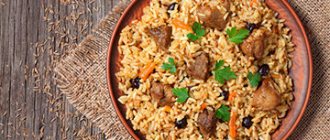The benefits of bell pepper
Most women during lactation are interested in whether bell pepper is beneficial or harmful when consumed.
Answering this question, it can be noted that the vegetable contains many minerals (iodine, manganese, chlorine, phosphorus, zinc, iron, potassium, calcium) and vitamins (groups B, E, C, A) necessary for the normal existence of the human body. Young mothers and babies especially need useful microelements in the first months of their lives.
Regular addition of sweet pepper to dishes is very useful: the product has a beneficial effect on the circulatory and immune systems, and prevents the development of thrombosis. Also, the positive properties of this vegetable include:
- improving the digestion of food in a baby, eliminating colic;
- stimulation of hair growth, prevention of hair loss and fragility;
- improvement of the condition of the dermis and visual organ;
- removal of harmful compounds from the body;
- reducing the likelihood of breast and ovarian cancer;
- eliminating fatigue, insomnia, providing the body with energy;
- improvement of the functioning of the central nervous system and pancreas.
In addition, bell peppers contain minimal calories and sugar compounds, so women with diabetes can eat them.
Is it okay to have green peppers while breastfeeding?
Green bell peppers are a little different from their fellow vegetables - sunny yellow, orange or bright red. The thing is that green sweet peppers are, in fact, simply fruits that have not had time to ripen, which did not have the opportunity to acquire their natural color.
Some experts claim that it is green pepper that has the maximum health benefits, and therefore can be present on the menu of a woman who is breastfeeding her newborn baby. People also believe that green pepper is preferable for another reason - supposedly it does not have a bright color, and therefore is much less likely to cause an allergic reaction in a newborn.
In fact, the composition of sweet peppers of any shade is approximately the same. The only significant difference is that green peppers have a more pronounced bitterness due to the fact that they were picked unripe. There are also slight discrepancies in the vitamin composition: nevertheless, green peppers are inferior to their brightly colored counterparts, because they contain slightly fewer useful elements.
Sweet peppers should be tried during breastfeeding only when the newborn baby has managed to grow up. Typically, pediatricians recommend avoiding this vegetable in the first months of breastfeeding; it is especially dangerous to eat it fresh.
And, although it is very beneficial for health, in the early period of lactation it can cause restless behavior in a newborn baby.
That is why it is best to postpone tasting green peppers during breastfeeding until the baby’s intestinal colic goes away. Also, to avoid possible allergies or the appearance of gas in the baby’s tummy, you should try a baked product or one that was cooked in a saucepan, steamed. Fresh vegetables are difficult for the gastrointestinal tract to digest.
Can bell peppers be consumed by nursing mothers?
During breastfeeding, young mothers should adhere to a special diet so as not to harm the baby. A woman's menu should include vegetables and fruits, so many people ask whether it is possible to eat pepper while breastfeeding.
The fruit in question is a product of average allergenicity. Therefore, despite the impressive list of positive properties, women during lactation should introduce it into their diet with caution.
Pediatricians advise adhering to the following recommendations:
- Start introducing a new product only when the baby reaches 3 months of age (not earlier). This is important, since the newborn’s digestive system is weakened; it will not be able to properly digest and assimilate such food. If the baby is prone to allergic manifestations, the product should be consumed no earlier than 4 to 5 months. life activity of the baby.
- Eat only seasonal fruit.
- The first few meals should consist of stewed or steamed fruit. You can also eat stuffed peppers or vegetable stew. If there are no side effects in the baby, you can gradually switch to consuming raw vegetables (in moderation).
- It is recommended to eat peppers that are greenish or yellowish in color; they are considered less allergenic. If, after introducing the product, the mother does not notice any changes in the baby’s well-being and/or behavior, you can start eating peppers of other colors.
- The first use of the vegetable should not exceed 20 g. The product must be eaten in the morning (not on an empty stomach). This is necessary so that the mother can observe the baby’s reaction during the day.
- The permissible weekly intake of boiled pepper is no more than 0.2 kg, of raw product - no more than 0.15 kg.
We recommend reading: Chocolate while breastfeeding
It is advisable to eat home-grown vegetables.
Can a nursing mother eat red bell peppers and what are their benefits?
Mothers in labor should follow the pediatrician's recommendations. The question of whether a nursing mother can eat sweet peppers in the first month after childbirth, when the newborn’s body is still very fragile, is especially acute. Doctors are quite loyal to this product and the reasons are as follows:
- When a young mother feeds her baby with breast milk, he receives nutrients from the foods she eats. Peppers contain the same amount of carotene as carrots. This substance helps improve vision and prevents the development of many diseases.
- During lactation, eating bell peppers is especially beneficial because it is enriched with vitamin C, antioxidants and folic acid. These components work to strengthen the baby's immune and nervous system.
- Yellow pepper is also recommended by experts during breastfeeding, especially for mothers who have problems with excess weight. Pepper in any form enriches the body with slow carbohydrates, which take a long time to digest and do not pass into fatty layers.
- During breastfeeding, green pepper delivers niacin and vitamin B to the body and has a positive effect on digestive processes.
- Pepper is rich in fiber, and this component is simply necessary for the intestines. It has anti-inflammatory enzymes and phosphorus, which has a positive effect on the human vascular system.
Some women do not know whether stuffed peppers can be given to a nursing mother, mistakenly believing that during heat treatment all the beneficial substances are lost. This vegetable in any variation will be an additional source of nutrients, and it will also help improve the quality of milk. The main caveat is the quantity. There should be moderation in everything, so you don’t need to eat this product in excess.
Important! Doctors strictly prohibit the consumption of canned foods, flour products and meat with a high percentage of fat. These products will make the milk tasteless.
When not to eat pepper
There are some restrictions on the introduction of pepper into a woman’s diet during breastfeeding. It is not recommended to consume this fruit for young mothers suffering from:
- epilepsy;
- pancreatic disease;
- ischemia and other heart problems;
- pathology of the nervous system;
- peptic ulcer of the stomach and duodenum.
If, after introducing the vegetable, the baby develops skin rashes, redness, bloating, or diarrhea, the product should be excluded from the nursing woman’s menu.
When and in what quantity can a nursing mother try bell pepper?
There are many varieties of pepper, so the recommendations for their use are different. It should be immediately noted that admission is allowed only after the baby turns three months old. During this period, you can eat white, yellow and green peppers. Red varieties should be included in the diet in the fourth month. In this case, you must first make sure that the child is not allergic to this product. There is also a limit on quantity: no more than 100 grams per week, but not at once, but by dividing into 3-4 servings. Ideal option: eat 30 grams every other day.
Important! Particular attention should be paid to the procedure for introducing this vegetable into the diet. It is worth starting with small doses and monitoring the child’s reaction.
How to choose the right vegetable?
When choosing sweet bell peppers, you need to ask the seller about the place where they are grown. Greenhouse and imported vegetables, as a rule, contain chemical compounds that are harmful to human health. It is recommended to give preference to fruits grown at home or on the farm. In addition, you should buy peppers only during the harvest season (summer or autumn). In spring and winter, chemical additives are used to grow fruits.
For a woman during breastfeeding and a baby, the color of the chosen vegetable is of no small importance. It is better to buy green peppers, since red and orange ones contain a large amount of allergic substances. You should also pay attention to the appearance of the product. The surface of the fruit should be smooth, without any dark inclusions or cracks, and the structure should be strong.
Red and black pepper during lactation
These spices have a whole range of beneficial properties, many of which are in demand by the woman’s body after childbirth. If there are no contraindications, feeding your baby is not an obstacle to adding black and red pepper to your favorite dishes.
In this case, you should be careful and introduce spices into dishes in small quantities. Otherwise, there is a risk that the baby’s body will react negatively to the active substances contained in pepper. Allergies and indigestion may occur. Therefore, it is definitely important to know how you can avoid possible symptoms of food allergies https://vskormi.ru/problems-with-baby/pischevaya-allerguya-u-grudnichka/.
We must not forget that spices, including red and black pepper, can change the taste of breast milk, making it bitter. Even if the baby tolerates this product well, you should not overuse spices - the child may refuse to feed.
Before you start peppering food or adding spices during cooking, check to see if your baby is allergic to these spices. It is important to carry out the test alternately for both types of pepper with an interval of at least a week, and pepper dishes to which the baby is already adapted - this will ensure the purity of the result.
The test is carried out according to the standard scheme - the new product is consumed in the first half of the day after feeding the baby, and then the baby’s well-being is monitored for at least 48 hours.
Subscribe to our VKontakte group
Cooking recipes
Below are options for the correct preparation of the vegetable in question, approved for consumption during guards.
Stuffed peppers (better prepared with vegetable filling)
Required components:
- sweet pepper (5 pcs.);
- a pair of onions;
- 25 g vegetable oil;
- 1 tbsp. low fat sour cream;
- carrot;
- cheese (to taste).
Steps to prepare stuffed peppers:
- Carefully cleaned of the insides and stalks of the pepper must be washed.
- Peel the onions and carrots, chop finely.
- Place the resulting mass on the bottom of the frying container, adding oil.
- Fry until golden, stirring.
- Fill the prepared peppers with vegetable filling, add sour cream mixed with a small amount of water (boiled and cooled).
- Sprinkle grated cheese mixture on top.
- Distribute the preparations into a baking dish, pre-oiled.
- Place the baking sheet in a hot oven.
- Cook for about 40 minutes.
We recommend reading: Chang Shu Purple Tea: Tibetan, composition, how to drink, use, contraindications
Cooked stuffed peppers can be sprinkled with finely chopped fresh herbs before serving.
Vegetable stew
Required ingredients:
- zucchini;
- 1 – 2 bell peppers;
- ½ kg each of potatoes and cabbage;
- bulb;
- a couple of small carrots.
Manufacturing steps:
- Wash and peel all the vegetables, then chop them into cubes of the same size.
- Shred the cabbage.
- Fry each vegetable separately from the others.
- Next, combine them, add salt, and place in a large bowl.
- Place the frying pan on the stove, turning on the heat.
- Pour in a little water, stir, leave to simmer for half an hour with minimal heat. The products need to be stirred periodically.
When serving, you can add a spoonful of sour cream to the stew. It should be borne in mind that greenish peppers can give the dish a bitter taste, so it is better to use red or yellow ones.











